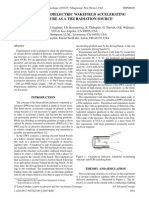S. Palazzo, K. Velkov, G. Lerchl, K. Van Tichelen
S. Palazzo, K. Velkov, G. Lerchl, K. Van Tichelen
Uploaded by
Isma-MACopyright:
Available Formats
S. Palazzo, K. Velkov, G. Lerchl, K. Van Tichelen
S. Palazzo, K. Velkov, G. Lerchl, K. Van Tichelen
Uploaded by
Isma-MAOriginal Description:
Original Title
Copyright
Available Formats
Share this document
Did you find this document useful?
Is this content inappropriate?
Copyright:
Available Formats
S. Palazzo, K. Velkov, G. Lerchl, K. Van Tichelen
S. Palazzo, K. Velkov, G. Lerchl, K. Van Tichelen
Uploaded by
Isma-MACopyright:
Available Formats
COMPARATIVE THERMAL-HYDRAULIC ANALYSIS OF THE MYRRHA
SPALLATION LOOP ADOPTING ATHLET AND RELAP5 SYSTEM CODES
S. Palazzo (), K. Velkov (), G. Lerchl (), K. Van Tichelen (*)
() Gesellschaft fr Anlagen und Reaktorsicherheit GRS(mbH), Forschungsinstitute, 85748 Garching b. M., Germany
(*) SCK-CEN, Boeretang 200, 2400 Mol, Belgien
ABSTRACT
In this work, the new version of the ATHLET system code will be tested, in which the physical properties of sodium, molten lead and LBE are implemented. The object of this study is the spallation loop of the MYRRHA facility, in
which the target LBE is circulated by forced convection to remove the heat deposited by the proton beam. A detailed nodalization is set up for performing thermal-hydraulic calculations both in nominal condition and in accidental
scenarios, in order to have a good characterization of the entire loop. Subsequently, the obtained results have been compared to the ones achieved with a previous simulations campaign, which was performed using a version of
RELAP5/mod 3.3 system code purposely modified at University of Pisa to account for LBE properties.
EXPERIMENTAL FACILITY
MYRRHA, a Multi-purpose Hybrid Research Reactor for High-tech Applications, is an experimental reactor which is planned to be built at the
Belgian Nuclear Research Centre SCK-CEN. It consists of a sub-critical nuclear reactor core (keff 0.95) coupled to an external neutron source. In
this external source, neutrons are produced by the spallation reaction, caused by a high intensity proton beam (3.0 mA and 600 MeV) which impinges
on a heavy liquid metal target (LBE).
Simulations matrix
The spallation loop basically consists of a big service vessel filled with LBE,
which is located beside the sub-critical core. From this main vessel, LBE flows
into the target spallation zone, where it interacts with the proton beam to
produce neutrons by the so called spallation reaction. Two horizontal tubes link
the central vertical tube, where actually the spallation reactions occur, to the
main confinement vessel.
The service vessel contains also the main circulation pump, an auxiliary
system for the control of the O2 content of the coolant, the measure
instrumentation and the vacuum system. The whole spallation vessel is kept
under vacuum to avoid the contamination of the beam line by gas released at the
interface between the spallation target and the proton beam.
ATHLET Nodalization RELAP5 Nodalization
TMDPVOL TMDPVOL
110 230
BRANCH BRANCH
100 220
PIPE PIPE PIPE
90 200 207
1.1 m
J-115 J-125
(J-85) J-195 J-198
BRANCH PIPE
80 120
0.815 m ANNULUS PIPE PIPE
130 190 197
(J-1) (J-2) J-188
BRANCH Di=0.075 m
140 Do=0.164 m
PIPE (J-3)
HTC Correlations 2.355 m 70 0.6 m
Q
PIPE
150
ANNULUS
187
JET MIXER D=0.164 m
160
0.765 m
PUMP
55 PIPE D=0.164 m
PIPE 162
50
TMDPJUN
315 J-45
PIPE J-165
40
TMDPVOL J-35
320
PIPE PIPE
310 30
PIPE D=0.106 m
170
2.57 m
J-305 J-25
PIPE
20
TMDPVOL J-15
300
PIPE
10 PIPE
180
J-185 J-175
1.75 m
5,2 START-UP AND STEADY STATE ANALYSIS 420
5,1
400
5,0
The main goal of Test A is to analyze the attainment of the operational
4,9
conditions using a specific start-up procedure. 380
4,8 Main Vessel ATHLET The pump is kept switched off for the first 100 s to obtain a correct
Temperature [ C]
Liquid level [m]
4,7 Main Vessel RELAP5 pressure distribution in the loop with stagnant fluid condition and then the 360
4,6 Beam tube ATHLET pump speed is changed linearly from 0 to 100% over the next 600 s.
4,5 The LBE flow rate in the secondary side of the HX is increased in a linear 340
Beam tube RELAP5
way during the first 100 s of the transient starting from 0 to 133 kg/s and
4,4 T_out ATHLET
then is maintained constant. 320
4,3 T_out RELAP5
The generated thermal power is released in the target zone through the
4,2 adjacent wall. In particular, it is not delivered in the first 200 s of the 300 T_in ATHLET
4,1 simulation to avoid a too high temperature increase until the mass flow T_in RELAP5
4,0 rate is relatively low. Following this phase, from 200 to 1100 s the thermal 280
0 500 1000 1500 2000 2500 3000 power is linearly increased up to the value of 1 MW and so maintained. 0 500 1000 1500 2000 2500 3000
Time [s] Time [s]
Liquid level variation in main vessel Inlet and outlet temperature
and beam tube components(Test A ) through the target zone (Test A )
The main goal of the first accidental transient (Test B) is to analyze the
160 behavior of the spallation loop in the event of small flow rate variation 1850
compared to the nominal flow rate. The required flow rate variation is
140 1650
obtained by changing the rotation pump velocity.
120 1450
Mass Flow Rate [kg/s]
Temperature [ C]
100 1250
ACCIDENTAL SCENARIOS
80 1050
T_in ATHLET
60 850
The purpose of Test C is to analyze the behavior of the spallation circuit T_in RELAP5
ATHLET when a sudden failure of the main pump occurs. T_out ATHLET
40 650
The pump rotation is reduced to zero within a few seconds, with the T_out RELAP5
RELAP5
20 consequent reduction of the LBE mass flow rate. The pump is turned off at 450
2000 s with a total coast-down time of 60 s and then is kept off in order to
0 250
0 1000 2000 3000 4000 5000 evaluate changes in temperature of the liquid metal in the circuit, while the
0 1000 2000 3000 4000 5000
Time [s] proton beam is still on, thus inducing heat in the spallation zone. Time [s]
LBE mass flow rate in the primary loop (Test B). Inlet and outlet temperature
through the target zone (Test C )
CONCLUSIONS
A thermal-hydraulic analysis of such spallation loop during operational and accidental transients is carried out using for the first time the new version of the system code ATHLET, in which the physical properties of lead, lead-
bismuth eutectic (LBE) alloy and sodium have been implemented. The obtained results have been compared with the ones achieved using a modified version of the RELAP5/mod 3.3 system code, showing a good agreement during
the simulation of both steady state and accidental scenarios in spite of different HTC correlations.
However, the representation of the spallation area with the target free surface, the free falling jet and the buffer space was not possible in a straightforward manner within both codes and a workaround was arranged using
junctions between different pipe components representing the beam tube and the target area and pressure loss coefficients were adapted. A further step will be to take advantage of the coupling technique already available between
the ATHLET system code and the computational fluid-dynamic code ANSYS-CFX in order to proceed to a very detailed thermal-hydraulic analysis of the whole loop.
______________________________________________________________________________________________________________________
International Workshop on Innovative Nuclear Reactors cooled by Heavy Liquid Metals: Status and Perspectives - Pisa (I), April 17-20, 2012
You might also like
- OLGA - Modeling Buried Pipelines Without FEMTherm - 6620827 - 03100% (1)OLGA - Modeling Buried Pipelines Without FEMTherm - 6620827 - 034 pages
- LCL Current Control Loop Stability DesignNo ratings yetLCL Current Control Loop Stability Design8 pages
- 08 Kobelco MARK 8 Mechatron Control Sistem100% (1)08 Kobelco MARK 8 Mechatron Control Sistem45 pages
- Auto-Transformer Design - A Practical Handbook for Manufacturers, Contractors and WiremenFrom EverandAuto-Transformer Design - A Practical Handbook for Manufacturers, Contractors and Wiremen4/5 (2)
- Minimum Current For Detachment of Electrolytic BubblesNo ratings yetMinimum Current For Detachment of Electrolytic Bubbles5 pages
- 2000 Energy Gauge For Lead-Acid Batteries in Electric VehiclesNo ratings yet2000 Energy Gauge For Lead-Acid Batteries in Electric Vehicles7 pages
- 2011 A Dynamic Unit Cell Model For The All-Vanadium Flow BatteryNo ratings yet2011 A Dynamic Unit Cell Model For The All-Vanadium Flow Battery7 pages
- Manipulation of Charge Transfer and Transport in PNo ratings yetManipulation of Charge Transfer and Transport in P9 pages
- Transient Analysis of Shunt Reactor SwitchingNo ratings yetTransient Analysis of Shunt Reactor Switching4 pages
- Voltage Relaxation and Impedance Spectroscopy As In-Operando Methods For The Detection of Lithium PlatingNo ratings yetVoltage Relaxation and Impedance Spectroscopy As In-Operando Methods For The Detection of Lithium Plating11 pages
- Analysis of Instabilities in Piezoelectric Transformers Driving Cold Cathode Fluorescent LampsNo ratings yetAnalysis of Instabilities in Piezoelectric Transformers Driving Cold Cathode Fluorescent Lamps6 pages
- CIRCUS and DESIRE: Experimental Facilities For Research On Natural-Circulation-Cooled Boiling Water ReactorsNo ratings yetCIRCUS and DESIRE: Experimental Facilities For Research On Natural-Circulation-Cooled Boiling Water Reactors6 pages
- Flow Analysis Inside A Pelton Turbine Bucket: B. ZoppéNo ratings yetFlow Analysis Inside A Pelton Turbine Bucket: B. Zoppé12 pages
- Passive_modelocking_MIR_quantum_cascade_laser_incorporating_self_induced_transparencyNo ratings yetPassive_modelocking_MIR_quantum_cascade_laser_incorporating_self_induced_transparency17 pages
- RIBER - RF Plasma Source For Hydrogen - RF H 600No ratings yetRIBER - RF Plasma Source For Hydrogen - RF H 6003 pages
- Time and Space Resolved Video Spectroscopy of The Vacuum Arc During The Formation of HCAVNo ratings yetTime and Space Resolved Video Spectroscopy of The Vacuum Arc During The Formation of HCAV11 pages
- Research_on_Inrush_Current_Mechanisms_of_Single_PhNo ratings yetResearch_on_Inrush_Current_Mechanisms_of_Single_Ph19 pages
- Rensselaer Heavy Ion Beam Probe Diagnostic Methods and TechniquesNo ratings yetRensselaer Heavy Ion Beam Probe Diagnostic Methods and Techniques19 pages
- 2D Numerical Simulations of Blade-Vortex Interaction in A Darrieus TurbineNo ratings yet2D Numerical Simulations of Blade-Vortex Interaction in A Darrieus Turbine15 pages
- An Equivalent Circuit Model of A Plasma Core InductorNo ratings yetAn Equivalent Circuit Model of A Plasma Core Inductor6 pages
- Shielding Charged Particle Emission From Ion Pumps: Technical OverviewNo ratings yetShielding Charged Particle Emission From Ion Pumps: Technical Overview8 pages
- Study of Recent Charge Pump Circuits in Phase Locked Loop: Umakantananda, Jyotirmayee Sarangi, Prakash Kumar RoutNo ratings yetStudy of Recent Charge Pump Circuits in Phase Locked Loop: Umakantananda, Jyotirmayee Sarangi, Prakash Kumar Rout7 pages
- A Pulser System With Parallel Spark Gaps at High RNo ratings yetA Pulser System With Parallel Spark Gaps at High R9 pages
- Mean-Field Approach to Dielectric Relaxation in GiNo ratings yetMean-Field Approach to Dielectric Relaxation in Gi7 pages
- Low-Voltage CMOS Charge-Pump PLL Architecture For Low Jitter OperationNo ratings yetLow-Voltage CMOS Charge-Pump PLL Architecture For Low Jitter Operation4 pages
- Simulation and Analytical Analysis of The Blumlein DischargeNo ratings yetSimulation and Analytical Analysis of The Blumlein Discharge7 pages
- Active Balancing Circuit For Advanced Lithium-IonNo ratings yetActive Balancing Circuit For Advanced Lithium-Ion7 pages
- Role of Air Bubbles in The Breakdown of Flowing Transformer OilNo ratings yetRole of Air Bubbles in The Breakdown of Flowing Transformer Oil9 pages
- 2011 Dynamic Analysisofwaveenergyconverterbyincorporatingtheeffect of HydraulictransmissionlinesNo ratings yet2011 Dynamic Analysisofwaveenergyconverterbyincorporatingtheeffect of Hydraulictransmissionlines12 pages
- The Blocking Oscillator On A Longitudinal WaveNo ratings yetThe Blocking Oscillator On A Longitudinal Wave2 pages
- Optical Pulse Propagation in A Fabry-Perot Etalon: Analytical DiscussionNo ratings yetOptical Pulse Propagation in A Fabry-Perot Etalon: Analytical Discussion8 pages
- Type CO Circuit Opening Overcurrent Relay - Autores Varios - Editorial ABB - 1984No ratings yetType CO Circuit Opening Overcurrent Relay - Autores Varios - Editorial ABB - 198424 pages
- Experimental Investigation and CFD Analysis On Cross Flow in The Core of PMR200No ratings yetExperimental Investigation and CFD Analysis On Cross Flow in The Core of PMR20036 pages
- 2011 Testing A Nuclear Pebble Bed Reactor Model in Openfoam - Bakx PDFNo ratings yet2011 Testing A Nuclear Pebble Bed Reactor Model in Openfoam - Bakx PDF41 pages
- IAEA Safety Standards: Deterministic Safety Analysis For Nuclear Power PlantsNo ratings yetIAEA Safety Standards: Deterministic Safety Analysis For Nuclear Power Plants84 pages
- Application of The Relap5/Pb-Bi Code To Safety Studies For The Ads Myrrha FacilityNo ratings yetApplication of The Relap5/Pb-Bi Code To Safety Studies For The Ads Myrrha Facility13 pages
- Nuclear Engineering and Design: Diego Castelliti, Guglielmo LomonacoNo ratings yetNuclear Engineering and Design: Diego Castelliti, Guglielmo Lomonaco12 pages
- 1.parts List 2.construction Instructions 3.assembly and Calibration Tools RequiredNo ratings yet1.parts List 2.construction Instructions 3.assembly and Calibration Tools Required6 pages
- Introduction To CANDU Systems and OperationNo ratings yetIntroduction To CANDU Systems and Operation258 pages
- Electronic and Optical Properties of CsSnI3 Ycly (Y 0, 1, 2, 3) Perovskites A DFT StudyNo ratings yetElectronic and Optical Properties of CsSnI3 Ycly (Y 0, 1, 2, 3) Perovskites A DFT Study9 pages
- Unit1.1The Principle of Industrial Process ControlNo ratings yetUnit1.1The Principle of Industrial Process Control5 pages
- 15.0 Non-Destructive Examination of Welds: Adiographic EstingNo ratings yet15.0 Non-Destructive Examination of Welds: Adiographic Esting5 pages
- Brainmaster Tanzania g3 Scie Monthly Test 2024No ratings yetBrainmaster Tanzania g3 Scie Monthly Test 20244 pages
- Efficient Prediction of Dynamic Responses-DelftNo ratings yetEfficient Prediction of Dynamic Responses-Delft178 pages
- Impedance-Based Winkler Spring Method For Soil-Pile Group Interaction AnalysisNo ratings yetImpedance-Based Winkler Spring Method For Soil-Pile Group Interaction Analysis0 pages
- Electrode Arrays: 4.6 DC Resistivity and IP Field Systems, Data Processing and InterpretationNo ratings yetElectrode Arrays: 4.6 DC Resistivity and IP Field Systems, Data Processing and Interpretation8 pages
- Analyzing Slope Stability by The Limit Equilibrium Method - American Society of Civil Engineers (2014) PDF100% (2)Analyzing Slope Stability by The Limit Equilibrium Method - American Society of Civil Engineers (2014) PDF378 pages
- (6648-0200-5-PS-DS-0026) 200-C-51 - Rev.FNo ratings yet(6648-0200-5-PS-DS-0026) 200-C-51 - Rev.F15 pages
- Rudy Rucker's Introduction To Speculations On The Fourth Dimension: Selected Writings Charles H. HintonNo ratings yetRudy Rucker's Introduction To Speculations On The Fourth Dimension: Selected Writings Charles H. Hinton15 pages
- Chapter TWO Kinetics of Particles: Work and EnergyNo ratings yetChapter TWO Kinetics of Particles: Work and Energy6 pages






































































































